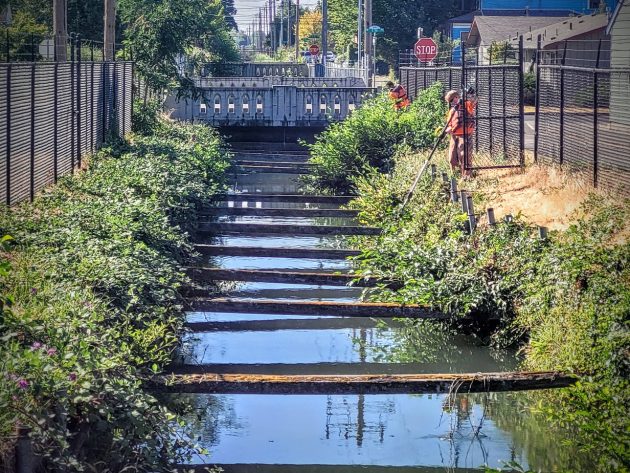
On Aug. 16, workers were laboring to clear the canal banks between Fourth and Fifth avenues of brush.
Traveling around Albany, whether on a bike or otherwise, means you’re likely to cross the Albany-Santiam Canal. Sometimes this waterway offers a mildly interesting sight.
Last month I happened to see a couple of people working on the canal beween Fourth and Fifth avenues. They were wielding what looked like pole-mounted power saws to attack the brush on the banks.
From the headworks on the South Santiam River above Lebanon to the water treatment plant and powerhouse on Vine Street, the canal is 18 miles long. That’s 18 miles of more of less regular maintenance, of which clearing vegetation is only a part.
For years now, some city officials have been working on a change in the status of the canal as a federally licensed system.
It was in March 2017 that the city council authorized the staff to begin working on this issue. The idea is to surrender Albany’s federal power license and instead obtain an exemption for the canal as a “small-source conduit.”
The city obtained a license for the system in 1998 from the Federal Energy Regulatory Commission (FERC). Then it began making improvements on the canal and the diversion dam on the river.
In late 2008, the new generator in the powerhouse started producing a little juice. In the years since, the power plant has operated off and on during the winter and early spring, but only when flow in the South Santiam is 1,100 cubic feet per second or more.
It’s not clear — at least to me — what exactly would change if and when the conduit exemption is granted. Operation of the canal presumably would still require the city to protect fish, for example.
The word from the city staff is that a draft application for the conduit exemption has been submitted to FERC. The final application is waiting for a signed agreement between the city and a handful of state and federal agencies dealing with protecting fish and other resources.
Most of the current city council members have not been faced with this issue since taking office. One of these days — or maybe one of these years — the regulatory changes will be in place and the council will be briefed.
Maybe then it will be clearer what the city has to do to keep the canal functioning as one of Albany’s two water sources, and whether it makes sense to try to generate power as well. (hh)

On Sept. 5, looking south along Albany’s Santiam Canal from the 12th Avenue bridge.

It would be nice to have this as a back up power system for the city, a large back up generator, keeping quiet that we have it. Kind of looking at it as an insurance policy, especially since the main power grid is coming under additional stress. As an everyday function, maybe use it for the electric vehicles that will eventually be coming on line, start building the infrastructure. Sounds like a fairly easy grant proposal to draft. Sounds like v1 is complete, getting the license, v1.1 complete, new generator mechanism, now it’s on the v1.2.
One is never going to be able to build a dam and generate power in this day and age, you do what most of us do, use what’s grandfathered in, what resources you already have. Also might look into adding a solar component when the Santiam falls below the CFS requirement, although the panel technology is still young, as it improves it won’t take as much area to mount the panels. Relying solely on someone else to ensure your well being is never a good strategy.
I often wondered how this water source worked. Thank you, Hasso for the deep dive into our water system. Is the area where the Santiam brings water our way visible near Lebanon?
Yes.
I’ve always wondered why the City of Albany did not apply for an exempt license from the start. Exemptions are granted for small plants and especially for those whose primary purpose is other than power generation. No yearly fee, possible to be excluded from the Dam Safety Monitoring program, and just lower operational/paperwork burden. Seems like the Albany plant is a very good candidate.
My quick take on conventional licenses yields this group.
P=project and facilitates searching FERC’s elibrary:
P-11509 City of Albany, Oregon City Of Albany, Oregon
P-11945 Dorena Lake Dam Dorena Hydro, LLC.
P-12686 Mason Dam Baker County, Oregon
P-12726 Rock Creek Eastern Oregon Light & Pwr Co. LLC.
P-14616 PacWave South Hydrokinetic Oregon State University
P-14803 Lower Klamath Klamath River Renewal Corporation
Great canal pictures, Hasso. I appreciate them. Thanks.